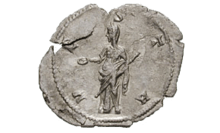Epulones
| Priesthoods of ancient Rome |
|---|
 Flamen (250–260 AD) |
| Major colleges |
|
Pontifices · Augures · Vestales Flamines · Septemviri epulonum Quindecimviri sacris faciundis |
|
Other colleges or sodalities |
|
Fetiales · Fratres Arvales · Salii Titii · Luperci · Sodales Augustales |
| Priests |
|
Pontifex Maximus · Rex Sacrorum Flamen Dialis · Flamen Martialis Flamen Quirinalis Rex Nemorensis · Curio maximus |
| Priestesses |
|
Virgo Vestalis Maxima Flaminica Dialis Regina sacrorum |
| Related topics |
|
Religion in ancient Rome |
The epulones formed one of the four great religious corporations (quattuor amplissima collegia) of ancient Roman priests. The two most important colleges were the College of Pontiffs and the augurs; the fourth was the quindecimviri sacris faciundis. The epulones arranged feasts and public banquets at festivals and games (ludi), duties that had originally belonged to the pontiffs.[1]
Initially there were three epulones, but later their number was increased to seven; hence they were also known as the septemviri epulonum, "seven men of the epulones." Julius Caesar temporarily expanded the college to ten, but after his death, it was reduced again to seven. Their college was founded in 196 BC, long after reforms had opened the magistracies and most priesthoods to plebeians, who were thus eligible from the beginning.[2] The necessity for such a college arose as the increasingly elaborate festivals required experts to oversee their organization.[3]
The patera was the sacred bowl used by the epulones. It was shallow with a raised center so that when held in the palm, the thumb could be placed on the raised centre without profaning the libation, as it is poured into the focus, or sacred fire. The patera was the special emblem of the epulones. The paten used today by Roman Catholic priests, omits the raised center.
References
- ↑ Andrew Lintott (1 April 1999). The Constitution of the Roman Republic. Clarendon Press. pp. 184–. ISBN 978-0-19-158467-1.
- ↑ Dictionary of Classical Antiquities, page 221
- ↑ Religion
External links
- Lacus Curtius website: Epulones from William Smith, A Dictionary of Greek and Roman Antiquities, John Murray, London, 1875.
- Roman Magistrates
- religio Romana: Patera
- Epulones
